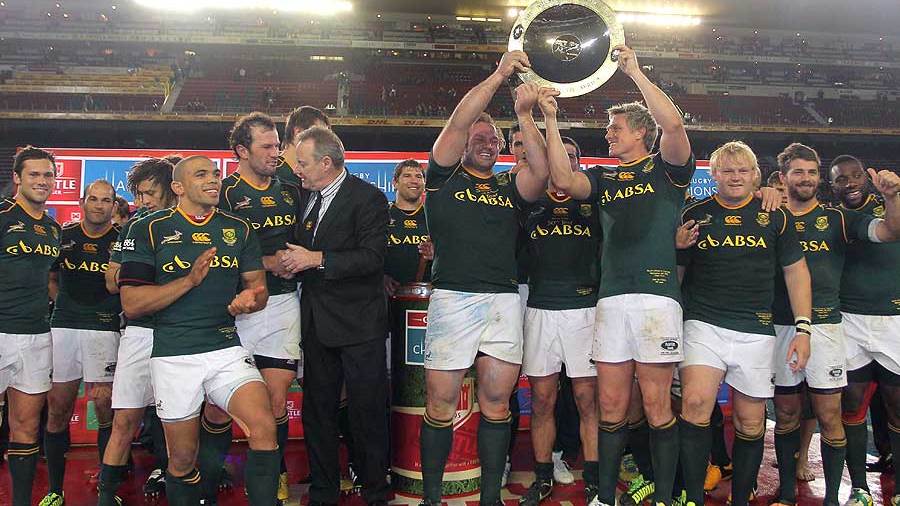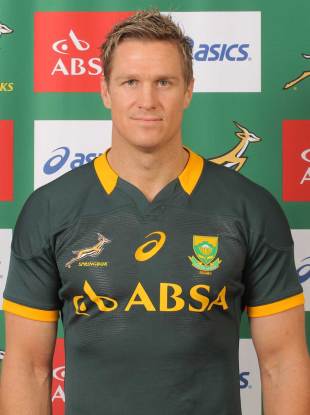|
South Africa
Keeping South African rugby's head above water
Firdose Moonda
April 25, 2014

South Africa continue to push the All Blacks who remain the No.1 side in the world © Getty Images
Enlarge
While Australian rugby is teetering on the edge of what a management consultancy has called a "financial precipice," and New Zealand contemplates the "major threat" of French money, as Rob Nichol the players' association chief put it, their SANZAR counterpart South Africa remains in a strong financial position. The South African Rugby Union (SARU) continues to report annual profits despite what CEO Jurie Roux called "an increasingly challenging financial environment," but it may need to look further than its southern hemisphere allies to keep doing so. SARU credit its ability to keep its heads above water in part to the restructuring process which took place during the 2011 financial year. That was when the organisation streamlined to combine the professional and amateur arms, which operated as separate companies since 2001, into a single entity which would answer to a single CEO. The merger allowed for "severe cost-cutting" according to Roux with the number of departments reduced from 16 to seven and expense dropping by 18%. In the two financial years which followed, 2012 and 2013, profits sat at R6.2 million (£369,000) and R5.1 million (£303,000) respectively, a sizeable drop from the 2011 amount of R24 million (£1,430,000) largely due to increased expenses around, among other things, the national team.
A simple explanation for the reason more money had to be spent on the Springboks was the inclusion of Argentina in the Rugby Championship in 2012. That added two fixtures to mid-year internationals to the usual six for a Tri-Nations and additional long-haul travel. That is a small example of why strengthening ties in the southern hemisphere can prove more costly than beneficial to South Africa. SARU has already realised that and there remains talk of it pulling its teams out of Super Rugby. A few weeks ago, there was talk South Africa would try to involve its franchises in a competition with European clubs, who were at a crossroads of their own following the English and French teams demanding an overhaul of the Heineken Cup structure. South Africa saw an opportunity to solve several problems by aligning themselves to what looked like a breakaway club competition. Playing in Europe would reduce the travel time and therefore the fatigue of South Africa's players. It would also mean all matches would be played in a timezone that best suited South African viewers, which could have led to the negotiation of bigger broadcast deals. Roux admitted SARU was considering engaging countries in the north before they struck a deal establishing new competitions. "It is an option that has been explored but the logistical issues are difficult and the recent agreement of a new European accord has reduced the opportunities," he said. Now that Europe is at peace, it has left South Africa with little choice but to continue with its SANZAR commitments, which are set to become bigger with an expanded Super Rugby competition although debate is ongoing. South Africa are set to get a sixth franchise in the tournament and it is likely both an Argentine and Japanese team will be added to the competition but the exact schedule is yet to be decided. It will likely mean fewer derby games, which South Africa will welcome, because they see those as too close a mirror to the domestic competition, but could result in more travel.

Jean de Villiers shows off South Africa's new shirt
© SARU
Enlarge
It may also result in less money. A report published by Global Media and Sports commissioned by the Australian players association RUPA, estimated increased costs of around £1.67m and reduced revenue by £3.87m which would affect the kitty of not just Australia - who have their own reasons for not wanting Super Rugby expansion which includes the need for the conference system to remain in place - but all involved parties. SANZAR revenue is currently split equally between the three countries so if the Super Rugby tournament makes less money, so will SARU. However, they are probably best placed to cushion the blow. While SARU regards the broadcasting rights for the SANZAR tournaments as "an important part" of its income, SARU has also noted the non-SANZAR Springbok Tests and domestic competitions generate significant revenue. Televisions rights fees make up only slightly less than half of SARU's annual revenue. The rest comes from sponsorships, which SARU continues to attract. Ultimately, SARU maintains it is not an organisation that is driven by profit and loss. Rather, it seeks to be financially well managed and if it earns more money, it aims to spend it on development. This January, it contracted 15 women's players for the first time in its history and launched ClubWise, an introduced an accredited training program for club administrators at grassroots level. Some of the funding for initiatives like the ones listed above comes from self-generated income through the SA Rugby Travel Program, the clothing range and the gate-takings from the Springbok Experience interactive museum which was opened in September last year. But these are small ways to add to the coffers and the purse strings are tightening. SARU credits its ability to register a profit in 2013, a year in which Roux confirmed they had to "remain within a budget that had to be revised downwards", to "prudent financial management." He anticipates the organisation will have to operate in this more careful environment for the next two years. Either that, or hope to find a way to make money by going north instead of staying south. © ESPN Sports Media Ltd
| |||||||||||||||
Live Sports
Communication error please reload the page.
-
Football
-
Cricket
-
Rugby
-
- Days
- Hrs
- Mins
- Secs
F1 - Abu Dhabi GP
Abu Dhabi Grand Prix December 11-131. Max Verstappen ()
2. Valtteri Bottas (Mercedes)
3. Lewis Hamilton (Mercedes)
4. Alexander Albon ()
5. Lando Norris ()
6. Carlos Sainz Jr ()
-
ESPNOtherLive >>
Golf - Houston Open
Snooker - China Open
Tennis - Miami Open

